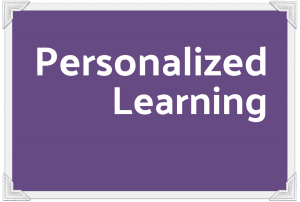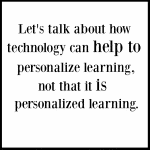Navigating the Nuances of Personalized Learning (Part 3)
CompetencyWorks Blog
 This is the third article in my reflection on the nuances of competency education. Read posts one and two.
This is the third article in my reflection on the nuances of competency education. Read posts one and two.
In this third and final reflection on how we can create deeper understanding of competency-based education and personalization, I dig into the different ways the phrase personalized learning is being used. A developmental orientation, in which we seek to explore the different emphases to create deeper understanding rather than a distinguishing one that sees these nuances as differences that confuse the field, is going to help us immeasurably in merging all of these concepts into the next generation learning system.
Technology: As schools began to build knowledge about how to integrate technology to support instruction, they began to realize the many ways it can provide opportunities for students to get more practice with rapid feedback, bring new ways to meet students where they are by making it easier for students to work on skills above or below grade level, and offer ways to enrich education by bringing the whole world into the classroom. Students begin to have options to access instruction, practice, and receive feedback on a computer, at least in some domains.
As described in the second piece of this reflection, the problem is that tech vendors grabbed hold of the terminology of personalization and suddenly, one of the understandings of personalization was reduced to the use of technology. Just like chalk and chalkboards once were, ed tech is a valuable learning resource. And it is a powerful one that can, when implemented effectively, open up the door to more innovations in how schools organize instruction, learning experiences, and supports.
 However, we get in trouble when we think of this as the only way to personalize education, as technology can’t do some of the most important parts of personalization. So let’s just call technology what it is – technology. And let’s talk about how technology can help to personalize learning, not that it is personalized learning.
However, we get in trouble when we think of this as the only way to personalize education, as technology can’t do some of the most important parts of personalization. So let’s just call technology what it is – technology. And let’s talk about how technology can help to personalize learning, not that it is personalized learning.
Choice: Choice is often the go-to for newbies trying to understand personalized learning. It is an important aspect of personalized learning but, like technology, it shouldn’t be understood as the only aspect. In fact, some schools jump to the idea that more choice means more personalization and offer students choices among five, ten, or twenty playlists. The problem is that this may actually be working against efforts to reduce the demand on working memory. If students are bewildered by the choices or don’t have adequate information to make a decision, they are then using working memory to make what might feel like a difficult decision rather than on the actual tasks at hand.
Agency or Student-Driven: Many definitions of personalized learning emphasize that students make decisions about their learning (see Personalize Learning and iNACOL for examples). It is based on one of the key findings in the science of learning: learning is an activity carried out by the learner. I know – it’s a no-brainer. Except that the traditional education system – bell-chiming, seats in a row schools, sage-on-the-stage schools – assumes a high degree of compliance and passivity. The traditional system operates on the misconception that what teachers say will simply be absorbed into the brain.
Let’s look at three big changes required for introducing student decision-making into schools. First, if you want students to carry out the activity of learning, then they need to learn the necessary skills and mindsets. A growth mindset is a must – it’s more than teaching children about how the brain works. It requires teaching them the skills to manage their own thoughts and actions (i.e., self-regulation). Other social & emotional skills are valuable as well. Metacognition is very important so that students can reflect upon their learning processes and strengthen them. Finally, habits of success – those behaviors, previously called study skills, will also make a huge difference in the ability of students to own their education.
Second, teachers need to have these skills themselves and have strategies and skills to help nurture them in students. We’ve never explicitly and intentionally asked teachers to do this before although they do it all the time. In traditional schools, teachers add or subtract points to extrinsically motivate students to demonstrate the habits of success. The problem is that points don’t work well if the student has already disengaged and doesn’t think of themselves as a learner. In fact, it can start to create a sense of unfairness.
Third, classroom management practices need to change so students have a chance to discover their voice, take responsibility, and practice decision-making. Many schools use codes of cooperation and standard operating procedures to build a shared responsibility for learning and help students learn what to do in different situations. Transparency of the learning targets, rubrics, and what proficiency look like is critically important, as is a way for students to know where they are in their own learning.
Interest and Need: Many explanations of personalized learning emphasize creating opportunities for students to explore interests and to meet their needs. Although these two concepts are packaged together, it’s best to look at them separately.
Opportunities to explore new context or pursue ideas that are of high interest are deeply related to increasing the motivation and engagement of students. The Students at the Center brief Motivation, Engagement and Student Voice is a great read on the topic. Although it is important to remember that there are other ways to motivate and engage students, creating ways for students to pursue high interests is very helpful. This might include providing choice in the novel they read or the country they focus on to demonstrate their understanding of the dynamics underlying civil wars. It might also include inquiry-based research, co-designing projects, and capstones.
Now look at the issue of needs. Differentiated instruction that meets students where they are is easily lost in the discussions on personalization. As outlined in this table, differentiation is different than personalized learning. Students need both, and the role of teachers is to help make sure both happen. Teachers help define the zone of proximal development based on students’ emotional readiness, academic needs, and the level of support that is going to be provided. Teachers provide the scaffolding to help students build the prerequisite skills as well as prompting questions to guide students toward accurate and deeper understanding. I want to emphasize this point: In competency-based schools the expectation is that schools and educators are taking responsibility for helping students to fill the gaps not just providing scaffolding to access grade level curriculum and then passing them on with gaps in knowledge and skills still unmet.
It’s possible that differentiated instruction is going to be integrated into the understanding of personalized learning. However, we shouldn’t let that mean we forget about it. In fact, the opposite is true. We need to understand the most effective strategies to meet students where they are that optimize learning and don’t lead us back to tracking.
There are also other types of needs that schools can help meet. Needs for more instructional support. Needs for intensive advocacy and access to services. Needs for more intensive guidance and adult interaction.
###
Our challenge is to understand each of these aspects deeply so they can be more easily integrated. Educators will be differentiating instruction while creating the conditions for students to be active learners by: 1) becoming better decision-makers about their education and 2) motivating and engaging student through opportunities for co-design, inquiry, and choice. All of which can be effectively supported through technology.
See also: